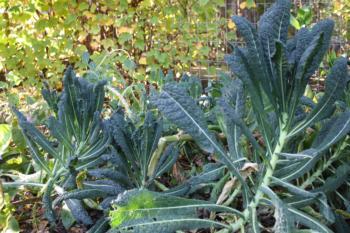What to plant in the fall-winter veggie garden
-
You might be ready for a break from your flower beds once winter arrives, but why not grow some delicious edibles while the rest of your garden is snoring? It doesn’t take much work or much space, it’s a lot more interesting than pruning roses, and the rewards are great. In fact, a few late fall nights of 28 degree temperatures produce super sweet-tasting cool season edibles! Chances are pretty good that you have room in your garden to tuck in a few Swiss chard starts or leafy braising greens. These types of edibles remind us that in our gentle climate we can have beauty – and food – in our gardens year round.

Kale is an easy winter crop that also adds color and texture to the garden.There are plenty of edibles that you can plant in wintertime, including garlic, leeks, onions, radishes, lettuce, peas, potatoes, chard, spinach, rhubarb, and other leafy greens such as bok choy and kale. If you've already planted these yummy treats, then you can harvest them straight through winter.
Tips for successful fall-winter food gardening:
• Defer planting until early fall to help conserve water
• Remove all plant material from warm season crops and add 3 inches of compost.
• Rotate planted areas (move this season's fall/winter garden if you planted one last year).
• Select edibles that germinate in soil temperatures between 40 and 60 degrees and mature quickly, such as those listed below.
• Plant fall/winter crops close together to minimize soil erosion.
• Add mulch — you can use leaves falling from your trees (just shred them first by running your lawn mower over them).Edibles that thrive in the fall-winter garden:
Garlic – Set out nursery-purchased bulbs (separated but unpeeled) four inches apart. Don’t water them in. It’s best to wait until shoots poke up before watering for the first time. Better yet, let the rain water them for you. Garlic requires very little room or attention.
Leeks – Nursery starts are inexpensive and plentiful. They can be harvested throughout the year and are unfazed by our mild winters.
Onions – This is where your well-amended soil is important. Onions love rich soil – not too sandy or clayey. And they like regular water. You can sow onion seeds, but it’s easier to buy bulbs (called “sets”) from a nursery or online source. Don’t try to plant grocery store onions because it’s unlikely to work. The best time to plant onion sets is January and February. (For green onions, or scallions, pull up the plants when they are about six weeks old.)
Radishes – Forget about those starchy red rocks called radishes at the grocery store. Search online to discover a long list of gorgeous radish seeds including French Breakfast, White Icicle and Pink Beauties. Easter Eggs is a particularly beautiful variety that produces radishes of varying purples, pinks and whites. Radishes grow easily and quickly, with some small-rooted varieties ready in a month or less from the day of seeding.
Lettuce – Like onions, lettuce appreciates fertile soil and regular water. Some are more suitable for warmer months, some for cooler. There are dozens of varieties, including heirloom and redleaf. Mesclun – a combination of several lettuces such as arugula, chervil, chicory and cress – grows beautifully in our climate. Sow seeds in January or February or check your local nursery for starts.
Peas – November and February are the best months to plant peas. Poke shelling or snap pea seeds an inch or two deep directly into rich soil and give them something tall to climb up and wind their tendrils around. Pea shoots are delicacies for birds, so you may need to cover your sprouts with a floating row cover or anything that keeps birds at bay but that lets sunshine and rain in.
Potatoes – Like peas, a good time to plant potatoes is in February, with the satisfying potato harvest around three months later. Potatoes are a joy to harvest for adults and kids alike. Depending on the variety, potatoes are usually grown from pieces of tubers that have at least one eye or from whole small tubers.
Swiss chard and other greens – Swiss chard is like an exclamation point in the winter vegetable garden, lighting up beds with bright pink, yellow and red stalks. It’s one of the easiest greens to grow either from seed or from starts, and it grows all year. Other greens, such as spinach, kale and bok choy, are also easy. These greens can be used for salads or can be braised in stir-fries or thrown into soups. Most greens relish cool temperatures and go to seed in warm weather. Give them rich soil, keep them cool and you’ll be rewarded with fresh salad greens throughout the year.
Original articles by Marie Narlock and Anne-Marie Walker
Edited for the Leaflet by Julie McMillan

